(Multi-page ad section from Audio magazine, Sept. 1987)
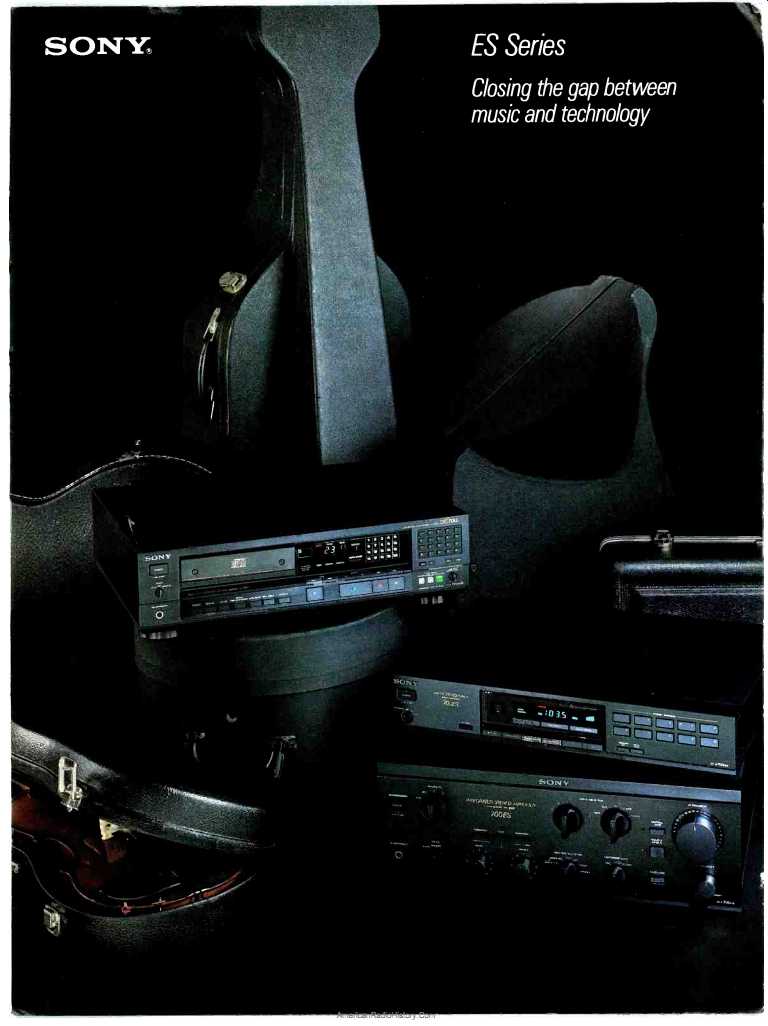
A promise fulfilled Digital audio has ushered in a new era in sound reproduction.
It holds the promise of dramatically improved sonic quality a listening experience that convincingly recreates the live musical event in your home.
The Sony ES Series is an exclusive, limited series of matched components. They are engineered without compromise to bring you all the benefits of Sony's many years of experience and technological leadership in audio. They, furthermore, incorporate refinements specifically designed to meet the demands of modern digital audio reproduction. In fact, when it comes to digital audio, ES Series components are in a class by them selves. They fulfill the promise of digital performance as no other components before.
No matter what the music source, Sony ES Series components assure you the best possible sound quality. They de liver superior sonic purity, clarity, and accuracy- a difference you'll hear the very first time you audition them and a difference you'll appreciate and enjoy for years to come.
Sony has led the way in digital audio.
No other manufacturer can claim more "firsts" in digital audio than Sony.
The digital revolution began to take shape in the early 1970's when Sony developed a PCM (Pulse Code Modulation) digital recorder for professional use. Since the beginning, Sony has played a significant role in the development of professional digital audio products. And today, Sony digital audio equipment is in use at prestigious music recording and production facilities around the world.
DIGITAL
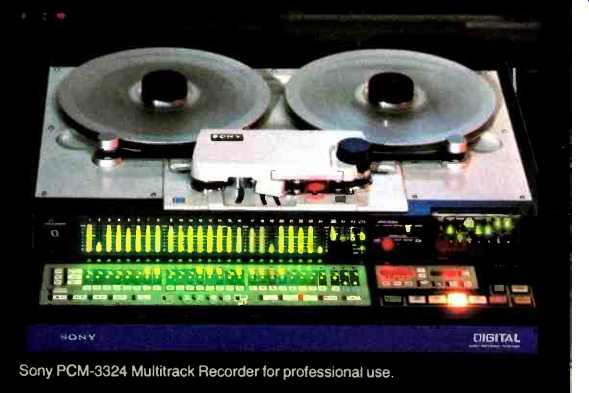
Sony PCM-3324 Multitrack Recorder for professional use.
In 1977 Sony introduced the PCM-1, a processor which permitted digital recording with any conventional VCR. The PCM-1 first made it possible for serious recording enthusiasts to take advantage of Sony's impressive digital technology.
Digital recording took another leap forward in 1981, when Sony unveiled the world's first portable PCM processor, the PCM-F1. Applauded by professional and amateur recording engineers alike, the PCM F1 brought the staggering clarity and accuracy of digital sound to thousands of music lovers the world over.
Then in 1982, Sony announced a product that made a profound and permanent impact on the high-fidelity industry-the first Compact Disc player. The CDP-101 Compact Disc player was acknowledged as an important breakthrough, opening the door to vastly improved sound quality and convenience in consumer audio.
Other Sony CD innovations soon followed. It was Sony that first produced portable and car CD players. Innovative concepts, such as the DiscMan and DiscJockey CD players, have put Sony at the leading edge of digital audio technology and have played major roles in making the CD format a marketing reality.
As the inventor of the CD format, Sony's experience in the design and construction of CD players is unsurpassed. From the 16-bit linear quantization system to the CD format's error correction methods... from extensive involvement in software production to the creation of the most highly regarded professional and consumer digital products...
Sony is truly THE LEADER IN DIGITAL AUDIO.
The ES Series--the quintessential expression of Sony's commitment to sonic accuracy.
Sony's remarkable digital audio technology has resulted in a new generation of music software and playback equipment that greatly increases the demands on associated hardware.
Connecting Sony's finest ES Series CD player to components of dated or less sophisticated design, for example, would result in a mismatch that could prevent you from realizing the full, dramatic capabilities of the CD format. To maximize your enjoyment of digital audio, you need the best possible components, designed specifically to elicit ultimate performance from the most demanding program source.
That's why Sony created the ES Series. Each ES Series component represents the state-of-the-art in its category. And collectively, they represent the highest achievement in Sony's continuing quest for perfection in audio reproduction.
ES Series components, moreover, are perfectly matched in engineering, quality, and styling. Nothing has been spared to make each component the perfect complement in a total system designed to deliver the utmost in listening satisfaction.
All CD players are not created equal.
Choosing a good CD player is of paramount importance if you wish to take full advantage of modern digital audio technology. But if you think that all CD players sound about the same because their specifications are similar, you're in for a surprise.
Sony's considerable research and experience in the design and manufacture of Compact Disc players has resulted in numerous engineering advances that make significant improvements in tracking and sonic performance.
Sony ES Series CD players incorporate a new generation of technologies that affect all critical areas of signal processing, including digital-to-analog conversion, filtering, and analog audio and power supply design. Further improvements in disc tracking and reliability have also been realized through the use of newly developed laser optic and mechanical assemblies.
New, exclusive Sony digital LSIs.
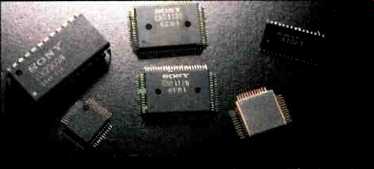
To implement many of these engineering refinements Sony had to develop its own large-scale integrated circuits (LSIs). The digital signal processing LSIs, for example, integrate up to 13 different digital functions into a single, miniature chip. The circuits employ C-MOS semiconductors for high thermal stability.
Separate Sony ICs handle other functions, such as optical system focusing, tracking, transport servo control, pulse width modulation, and digital-to-analog conversion.
These proprietary chips greatly simplify the signal path, consume less power, and generate less heat... all of which results in improved reliability.
And their advanced design is one of the primary reasons Sony ES Series CD players sound better and perform more dependably.
Compact Disc Players
UniLinear Converter with 4X Oversampling Digital Filter
Sony ES Series CD players employ a sampling frequency that is 4 times higher than the standard 44.1 kHz rate for digital filtering.
Decoding at this higher rate provides no additional music information, but it shifts the noise band to a much higher frequency so that a final stage filter with a gentle slope can be used. compared to the steep "brick wall" analog fitters used in conventional designs, this digital filtering technique results in vastly improved phase linearity and virtually no ripple (less than + / - 0.001 dB) at the higher audio frequencies.

While digital filtering does solve the problems associated with steep analog filters, the interaction of multiple clock rates four in typical oversampling designs creates high-frequency spurious noise. ES Series CD players are free of such noise thanks to Sony's exclusive UniLinear Converter, which utilizes a single "master clock" to synchronize all digital decoding functions.
It all adds up to smoother, cleaner, untiring sound reproduction from your favorite CDs.
Noise Spectrum Comparison Typical 16-bit Oversampling:

Converter Deglitcher Circuit
Most CD players add a "sample-and-hold" circuit to eliminate occasional noise bursts, generated by even the best of D/A converters. Such circuits, however, tend to exhibit "memory' characteristics that preclude accurate response due to minute changes in signal level.
Sony's newly developed D/A converter, however, utilizes advanced current accumulation technology that corrects for "glitches" during the digital-to-analog process, thus eliminating the need for sample-and-hold circuitry. ES Series CD players, as a result, deliver dramatically improved sonic resolution at all listening levels.
Error Prediction Logic:
Conventional players rely only on a servo feedback circuit to correct for tracking errors caused by occasional disc defects. The amount of compensating current required varies in proportion to the size of the defect
The resulting fluctuations in servo current causes power supply instability and increased levels of magnetically induced noise.
Sony's Error Prediction Logic (EPL) system employs a micro processor to determine the pr able location to m disc's rotation ond within the fi tions after a defect is initially detected. The system the rects the servo circuit to spond with the precise amount of current required immediately prior to the predicted occurrence of the defect. The frequency and amount of servo compensation required to adjust for most errors is thus dramatically reduced.
Error Prediction logic EPL circuitry improves tracking response and servo stability in Sony ES Series CD players. And occasional disc defects won't cause excessive power supply fluctuations that can result in noise.
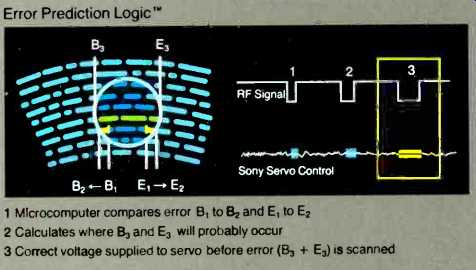
1. Microcomputer compares error B1 to B2 and 1 to E2
2. Calculates where B3 and E3 will probably occur
3. Correct voltage supplied to servo before error (B2 + E3) is scanned
CDP-705ESD


A new reference standard for CD players.
A Compact Disc player incorporating Sony's most sophisticated digital audio technology and control features to let you fully appreciate the tremendous capabilities of the CD format.
- G-Chassis construction for total vibration absorption
- Optical Transfer System for superior analog/ digital isolation
- 20-key Direct Access for instant track selection
- 20-selection Random Music Sensor (RMS), Automatic Music Sensor" (AMS), High-Speed Manual Search, Index Search, and Shuffle Play provide extensive playback programming and track access capabilities
- 5 repeat modes (single, all, RMS, Shuffle, A-B) give you a variety of extended listening options
- Music Calendar & 6-mode Timekeeper for complete status display: track number, index number, track elapsed time, track remaining time, disc remaining time, and programmed remaining time-
- Variable line output permits independent adjustment of volume level
- Full-function wireless RM-D502A Remote Commander unit (supplied) provides total control of all operating and programming features, including line output level
CDP-605ESD
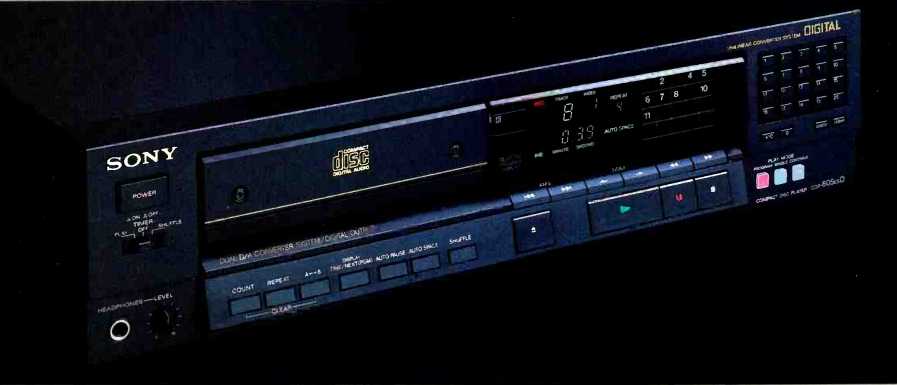

A new level of Compact Disc performance.
Unprecedented playback versatility combined with awesome sonic capabilities. A CD player that truly represents the state of the digital audio art.
- Dual-Chassis construction for exceptional rigidity
- 20-key Direct Access', for instant track selection
- 20-selection Random Music Sensor (RMS), Automatic Music Sensor (AMS), High-Speed Manual Search, Index Search, and Shuffle Play provide extensive playback programming and track access capabilities
- 5 repeat modes (single, all, RMS, Shuffle, A-B) give you a variety of extended listening options
- Music Calendar & 6-mode Timekeeper for complete status display: track number, index number, track elapsed time, track remaining time, disc remaining time, and programmed remaining time
- Full-function wireless RM-D550A Remote Commander® unit (supplied) provides total control of all operating and programming features
Compact Disc Players
Dual DMA Converters
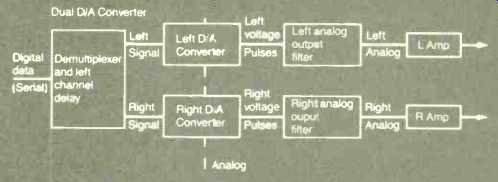
Sony ES Series CD players feature full 16-bit dual D/A converter circuitry. Unlike typical players that must "time share" a single converter through data multiplexing, this design permits both channels to be decoded simultaneously. There is virtually no interchannel time delay. The lack of interchannel time delay ensures a more precise and stable stereo image. What's more, Sony uses two separate converters that are precisely matched for optimum linearity.
Linear Motor Tracking Mechanism

Conventional CD players utilize a DC motor to move the optical pickup through a complicated system of worm and reduction gears. Such systems suffer from mechanical "play' which makes smooth, precise motion difficult to achieve.
The advantage of Sony's Linear Motor Tracking Mechanism, featured on all Sony ES Series CO players lies in its simple construction--the linear motor's torque is applied directly to the pickup. The velocity sensor is also attached directly to the pickup, giving instant, accurate feedback to the servo system.
The low-mass laser pickup, linear motor, and velocity sensor are unitized to eliminate un wanted mechanical play and backlash. The entire compact assembly rides on oil-damped bearings to ensure durability.
And, a low resonance Cerasin material is used to improve sound quality.
CDP-505ESD

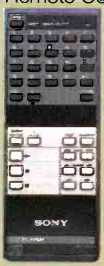
An exceptional value among CD players.
The most affordable ES Series CD player with a degree of technical refinement and control flexibility uncommon at its price.
- Monocoque chassis construction for extra rigidity
- 20-key Direct Access"' for instant track selection
- 20-selection Random Music Sensor (RMS), Automatic Music Sensor' (AMS), High-Speed Manual Search, Index Search, and Shuffle Play provide extensive playback programming and track access capabilities
- 5 repeat modes (single, all, RMS, Shuffle, A-B) give you a variety of extended listening options.
- Music Calendar & 6-mode Timekeeper for complete status display: track number, index number, track elapsed time, track remaining time, disc remaining time, and programmed remaining time
- Full-function wireless RM-D350A Remote Commander unit (supplied) provides total control of all operating and programming features
Outboard Digital-to-Analog Converter
The Sony Linear Motor Tracking Mechanism ensures fast access speed, precise cueing, and smooth tracking. It produces far less mechanical noise than conventional gear-driven designs, and is simplicity results in unsurpassed reliability and long service life.
Multiple Power Supply Design
Sony has alw neec for hi power supplies for the digital andµ analog circuits provide the needed stability and help eliminate electrical interference and noise leakage between stages.
The CDP-605ESD and CDP 505ESD players have power sup plies with separate windings on the power transformer for the digital and analog stages with dedicated regulation circuitry.
The CDP-705ESD delivers the ultimate in power supply stability with separate, large-capacity power transformers for the digital and analog sections, plus nine different power sub-regulators, in a completely independent …These steps ensure superior regulation and isolation of circuit stages for ultra-clean, noise-free audio performance.
Direct Digital Output
Sony pioneered the concept of transferring music information in digital form through standardized interface ports. All ES Series CD players now provide a direct digital output that fully conforms to industry format standards. This output makes Sony ES Series CD players ready for interface with future genet.
dio compo And with the Sony DAS-7031 output any " cries' player can be connected to th
DAS-703ES to provide state-of the-art digital decoding for the ultimate in CD playback.
The digital output stage in ES Series CD players is designed with special "latch" circuitry to correct for any time-based error caused by jitter. Furthermore, when the digital port is used, the player's analog stage is completely bypassed to eliminate any internal interference with the digital data stream.
Conventional digital output stage Sony time-base corrected digital output stage
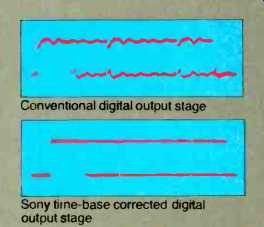
DAS-703ES
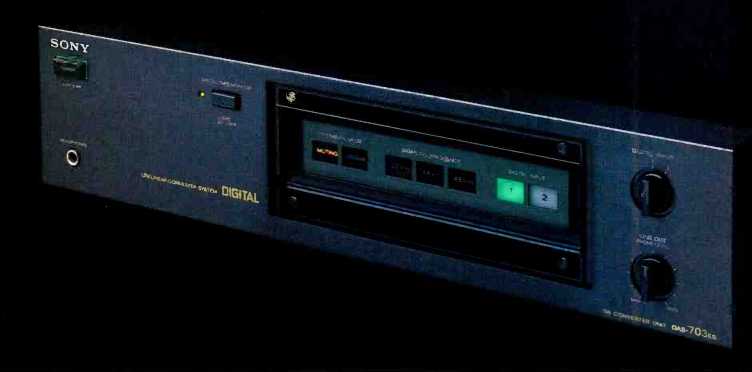
A step into the future of digital audio.
An outboard digital-to-analog (D/A) converter featuring automatic selection of four different sampling rates. Designed to decode digital audio signals with uncompromising accuracy for reproduction of stunning clarity and definition.
- Optical Transfer System for superior analog/ digital isolation
- Dual D/A Converters eliminate interchannel time delay
- Separate large-capacity power transformers for digital and analog circuitry increase power supply stability and reduce interference and noise
- Double PLL Clock System for improved decoding accuracy
- Left/Right Dual Monaural construction for reduced interchannel interference
- Recommended for use with Sony ES Series CD players featuring direct digital output
- Capable of decoding 4 sampling rates-32 kHz, 44.056 kHz, 441 kHz, and 48 kHz; compatible with most digital audio sources, such as PCM processors and future PCM broadcasts and digital audio tape recorders (DAT)
- Digital Monitor Switch for future applications
- Ultra-high-grade, selected circuit components
- LC-OFC (Linear Crystal, Oxygen-Free Copper) wiring used for all analog signal paths
Amplifiers
Superior amplifiers for superior program sources Sony ES Series integrated amplifiers are the result of extensive research into ALL of tie factors that affect sonic performance, including a few not previously recognized. Like other ES Series components, these amplifiers reflect no-compromise engineering. They incorporate technological advances tat result in audibly superior reproduction with virtually any high-quality program source, especially a well-engineered, properly decoded Compact Disc.

G-Chassis (Gibraltar Chassis) Construction: Power transformers, power transistors, and other amplifier parts generate vibration during normal operation. There are also external sources of vibration, such as sound waves transmitted through the air and floor from the speakers. The transistors and capacitors that handle low-level signals in an amplifier can convert these vibrations into electrical signals that can modulate the audio signal and rob an amplifier of sonic purity.
The G-Chassis employed Sony's ES Series ampli made of a unique calcium carbonate polyester resin rein with glass fibers, similar in molded at high temperature into a single piece, onto which the power transformer, heat sink and PC board assemblies are mounted. The structure is approximately 3,000 times more rigid than a conventional steel C. is.
Standard chassis vibration G-Chassis vibration suppression Sony's 6-Chassis is not only exceptionally immune to vibration, but also totally non-magnetic.
Distortions and colorations caused by vibrational energies and magnetic fields are virtually eliminated. Sony ES Series amplifiers thus achieve a purity in sound that cannot be matched by amplifiers of conventional chassis design.
Spontaneous Twin-Drive Power Supply
Sony ES Series amplifiers incorporate a novel Spontaneous Twin Drive design, which utilizes separate power supplies for the voltage amplification and power output stages. Each power sup ply is independently rectified and filtered with large capacitors.
This eliminates power supply fluctuations for the earlier voltage amplification circuitry even! when the power output stage is drawing heavy current.
Spontaneous Twin Drive results in consistent amplifier performance under a wide variety of signal loads. The sound quality is always clear with accurate re production of musical dynamics.
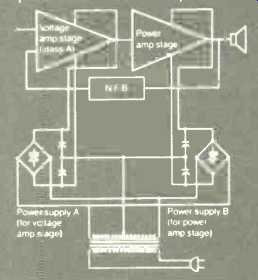

Low-Impedance/High-Current Drive
Amplifier current requirement in creases as a speaker's impedance decreases. And an amplifier must be able to stably deliver this current regardless of the fact that no speaker behaves like a purely resistive load.
Sony ES Series amplifiers are capable of delivering high cur rent with stable consistency to virtually any load, even at 1-ohm.
Large amounts of clean, undistorted power are always avail able, even for speakers of low and/or complex impedances.

Source Direct Capability: Sony ES Series amplifiers include Source Direct capability. A touch of a button routes the input signal directly to the amplifier's volume attenuator, completely bypassing the filter, tone control, and balance circuitry.
Passive Tone Control Circuitry: Sony ES Series amplifiers employ sophisticated passive tone control circuitry consisting only of capacitive and resistive components. Tone control action is de signed to be dependent on volume attenuator setting to provide a refined loudness compensation system.
The passive tone control circuitry in Sony ES Series amplifiers provides highly useful tonal adjustment capability without the signal degradation associated with conventional active-type controls.
TA-F700ES
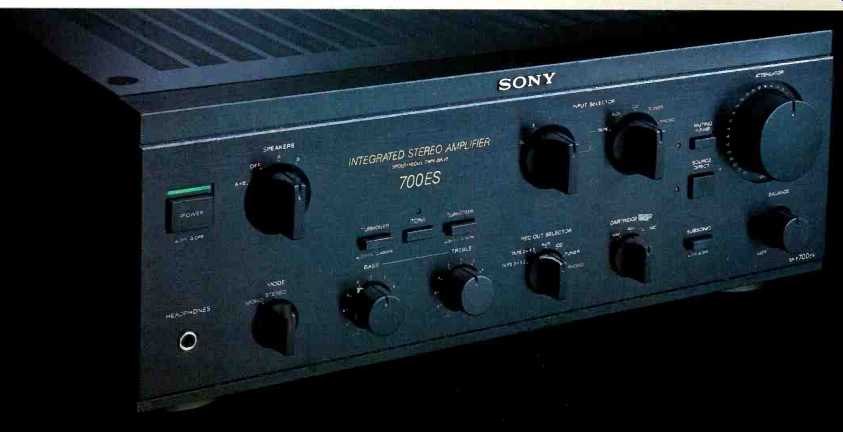
An amplifier of unparalleled sonic purity.
Capable of delivering astonishingly clean, solid power. Reproduces the fine detail and tremendous dynamics of digital audio with consummate transparency and ease.
- 140 Watts per channel continuous output at 4 ohms, 20 Hz-20 kHz, 0.008% THD
- 105 Watts per channel continuous output at 8 ohms, 20 Hz-20 kHz, 0.004% THD
- Spontaneous Twin-Drive assures consistent amplifier performance under a wide variety of signal loads for accurate reproduction of musical dynamics
- Phono input fully compatible with moving magnet and moving-coil cartridges
- Passive tone control circuitry (with switch selectable bass and treble turnover frequencies) maintains high signal integrity
- Independent record output selector lets you tape one signal source while listening to another
- Defeatable subsonic filter removes undesirable and potentially harmful ultra-low-frequency signals, such as those caused by turntable rumble or record warps
- Connections for 3 tape decks with dubbing capability
- Connections for 2 speaker pairs with A/B/A + B switching
TA-F500ES

An audibly superior integrated amplifier.
Generous power reserves and innovative Sony amplifier technology for performance that does justice to the finest digital and analog sources. Truly an amplifier for the audio purist.
- 100 Watts per channel continuous output at 4 ohms, 20 Hz-20 kHz, 0.01% THD
- 80 Watts per channel continuous output at 8 ohms, 20 Hz-20 kHz, 0.006% THD
- Spontaneous Twin-Drive assures consistent amplifier performance under a wide variety of signal loads for accurate reproduction of musical dynamics
- Phono input fully compatible with moving-magnet and moving-coil cartridges
- Passive tone control circuitry maintains high signal integrity
- Independent record output selector lets you tape one signal source while listening to another
- Defeatable subsonic filter removes undesirable and potentially harmful ultra-low-frequency signals, such as those caused by turntable rumble or record warps
- Connections for 2 speaker pairs with A/B/A + B switching
Tuners
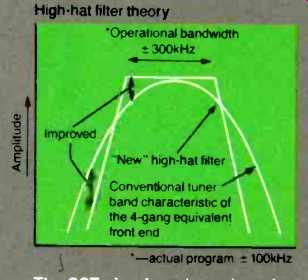
New Tuner technology for improved FM reception: Many FM stations have invested in new equipment, including Compact Disc players and state of-the-art transmitting systems, to take advantage of the inherently high quality of digital audio sources.
RF interference from strong adjacent stations, however, often pre vents the listener from enjoying the fine signal quality of a more distant or weaker station.
To combat this problem, Sony has developed an impressive series of FM tuner circuits. These Wave Optimizer technologies have been incorporate] for the first time in the ES Series tuners.
Super Sound Tracking Circuitry: To increase rejection of unwanted signals, a steeper, narrower front end filter must be used. But if a filter is made too narrow, phase and amplitude distortions will degrade signal quality. And with large signal modulations, the "shoulders" of a narrow filter can actually clip off components of the desired signal.
The Sony ST-S700ES tuner em ploys a unique Super Sound Tracking (SST) front end that continuously shifts the center of the bandpass filter in response to the frequency modulations. This effectively results in ideal "high-hat" filter characteristics, which provides the excellent selectivity of a narrow filter without the normally associated phase and amplitude distortions.
The SST circuitry also solves the problem of front end tracking error, which occurs when the center of the bandpass filter is not at the exact frequency of the broad cast signal. SST eliminates such error by using separate control voltages for the front end and RE tuning sections with varying degrees of compensation across the FM reception band.
Sony's SST front end design assures high rejection of unwanted signals while maintaining low distortion. It enables the ST S700ES tuner to provide superior signal clarity even in "crowded" reception areas.
Wave Optimized IF System: The Wave Optimized IF System (WOIS) used in the ST-S700ES tuner automatically selects optimum filter characteristics based on signal condition. Whether the signal is monaural or stereo, whether there are strong adja always select the appropriate set of IF filter characteristics to '0 give you the lowest possible distortion without interference.
Wave Optimized Dire Detector: Conventional PLL designs suffer from excessive distortion be cause varying the control voltage applied to the varactor diode cannot linearly change the VCO (voltage-controlled oscillator) frequency.
Sony has solved this problem in the ES Series tuners with the Wave Optimized Direct Detector (WOOD). This circuit uses a special FET circuit to produce an intentionally non-linear characteristic that precisely compen-
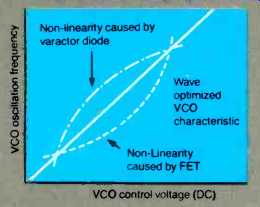
The result in Sony's ST-S7000ES tuner is PLL detector that exhibits extremely low distortion and noise.
Wave Optimized Digital Stereo Decoder: Sony ES Series tuners feature a Wave Optimized Digital Stereo Decoder (WODSO). It takes the composite signal from the IF stage and switches it at a rate of 38kHz. This switched signal is blended with another special waveform which is produced through balanced multiplication of 38kHz and 114kHz signals. The resulting audio frequency signal does not contain any harmonics of the switching signal. Thus any high-frequency interference components that may have been present in the original composite signal are not demodulated into the audible frequency range.
WODSD eliminates the need for the conventional beat-cut filters. It effectively suppresses high-frequency interference without introducing phase and amplitude distortions. Sony ES Series tuners are thus able to provide stereo FM reception of exceptional fidelity.
Oscilloscope photos show that WODSD effectively suppresses high-frequency interference for exceptional FM fidelity
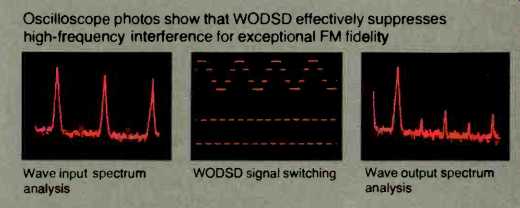
ST-S700ES

Incomparable FM reception quality.
A tuner that ensures the best possible reception for full enjoyment of today's finest-quality FM broad casts. Features the full complement of Sony's unique Wave Optimizer technologies for superb performance even in difficult reception areas.
- Super Sound Tracking front end design
- Wave Optimized IF System
- Wave Optimized Direct Detector
- Wave Optimized Digital Stereo Decoder
- Exclusive Direct Comparator circuitry for the accuracy of quartz frequency-synthesis tuning without the commonly associated noise
- Timer program capability permits pre-selection of up to 4 stations for sequential unattended recording
- 10 station memory presets for instant, one-button recall of favorite stations
- Multi-process memory "remembers" various tuner settings for each preset station
- Memory Scan gives you a 4-second sample of each preset station
- Calibration tone facilitates presetting of record levels when taping off the air
Cassette Deck
Cassette performance that meets the digital challenge. The Sony ES Series cassette deck is the result of an intensive effort to produce a recording instrument that would be capable of faithful reproduction with today's most demanding program sources.
Mid-ship Drive System: A lavishly constructed chassis separates the system control circuitry, in the left third of chassis, from the audio circuits, which occupy the right third. The center "mid-ship" portion of the unit houses the tape transport mechanism and power supply components in a separate inner chassis.

The physical separation of the system control section from the audio circuits eliminates electrical interference. It also eliminates excessive internal wiring and simplifies the signal path.
The results are exceptionally low-noise audio performance.
The inner mid-ship chassis adds structural rigidity, which helps control vibrations and resonances that can adversely affect tape transport and audio circuitry performance.
Ruin Monaural DC Amplifier Design: Entirely separate PC boards are used for the record and playback amplifiers, which are of an advanced DC design that reduces dependence on distortion-causing coupling capacitors.
Each PC board is, in addition, designed with physically separate sections for the left and right channels. This symmetrical twin monaural design significantly reduces interstage and interchannel interferences for unparalleled reproduction clarity and improved stereo separation.
LC-OFC LaserAmorphous 3-head Design with Independent Suspension: Sony's extraordinary Laser- Amorphous head features laser-welded laminations made from an amorphous (non-crystalline) material that possesses nearly ideal magnetic characteristics.
Coils are wound using linear-crystal, oxygen-free copper (LC OFC) wire, known for its superb conductive characteristics.
The Laser-Amorphous head exhibits far superior linearity and lower noise when compared to conventional heads. It ensures wider dynamic range and ex tended frequency response. And its physical hardness makes it one of the longest-lasting heads available.
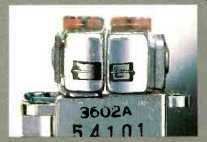
With typical 'combination' heads, slight azimuth misalignment between the heads is virtually unavoidable and permanent. The sophisticated in dependent suspension system on the ES Series cassette deck, however, permits the erase and separate LaserAmorphous re cord and playback heads to be independently aligned at the factory. It assures perfect head alignment and, thus, the best possible high-frequency performance and signal-to-noise ratio.
Closed-Loop Dual Capstan Transport with Quartz-Lock Direct-Drive: Sony's advanced closed-loop dual capstan transport ensures perfect tape tension and optimal tape-to-head contact regardless of the vagaries of the plastic cassette housing.

---Close- Loop Capstan System
The capstan and flywheel on the take-up side, furthermore, are integral parts of a sophisticated Sony 3-phase linear-torque BSL (brushless/slotless) direct-drive motor with quartz-lock digital servo. In the closed-loop dual capstan configuration, it delivers precise, steady tape travel with remarkably low wow-and-flutter: less than 0.025% (WRMS).
Record Level and Bias Calibration: Even the best of tape formulations can slightly vary in characteristics from batch to batch.
That's why the Sony ES Series cassette deck includes a front-panel calibration system with built-in test tones that permits you to adjust record level and bias for the best possible performance with virtually any high-quality tape formulation.
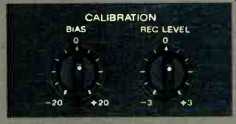
TC-K700ES
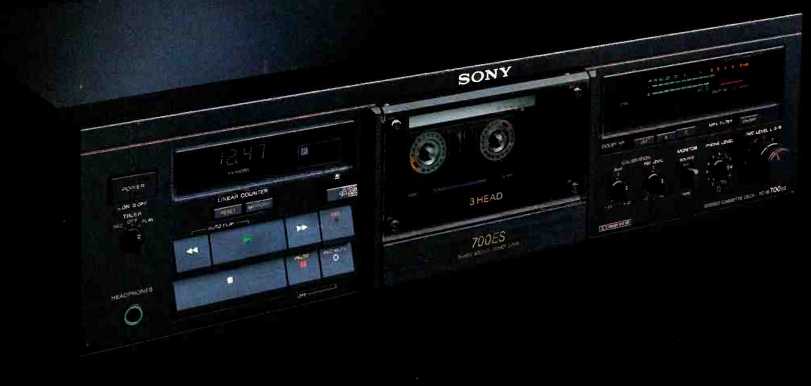
For those who seriously record.
Features highly sophisticated design and construction, unsurpassed magnetic head technology, state-of-the-art tape transport, superb electronics, and advanced performance capabilities. Capable of accurately capturing the detail and dynamics of digital audio sources.
- Dolby B/C noise reduction system uses Dual Symmetry IC for simplified, efficient circuitry
- Linear Counter for "real time" indication of tape position
- Memory stop/play halts the transport or begins playback when the counter reaches "0.00" during rewind
- Subtract function on counter for remaining time indication
- Automatic tape type selection makes it impossible to accidentally record or play with the wrong bias/equalization
- MPX filter switch lets you remove the 19 kHz carrier signal that can cause errors in Dolby system tracking when taping FM stereo broadcasts
- Auto Play automatically puts transport into play mode after rewind
- AutoSpace Record Mute facilitates consistent spacing between recorded selections
- Timer Record/Play permits unattended record or playback-puts the deck in record or play when power is turned on, e.g., via an external program timer
- Headphone output with volume control
Sound Processors
SEQ-333ES

The perfect equalizer for less-than-perfect listening environments.
An "intelligent", remote control equalizer that automatically adjusts for room acoustics. Features 10 bands of equalization with real-time spectrum analysis. A sophisticated component that greatly enhances your listening pleasure.
- Precision test microphone included for room acoustic equalization
- 3 inputs and outputs
- 8 acoustic memories with 4 pre-programmed curves for the most popular listening conditions
- Choice of automatic or manual equalization provides maximum versatility
- Battery backup holds programmed settings
SDP-505ES

The most convincing sonic illusions yet.
A digital surround processor featuring five different delay modes. Reproduces surround sound and ambience effects with the wide dynamic range, low distortion, and low noise demanded by digital audio.
- Includes Dolby Surround Sound decoding
- Utilizes a 44.1 kHz sampling rate and full 16-bit quantization (the same as the CD format)
- Independent left/right channel delay adjustment
- Built-in pink noise calibration generator
- 3 delay memory presets
- Built-in 14 watt per channel stereo amplifier
Speakers
Speakers ideally suited to digital audio reproduction
During Sony's developmental work on digital audio and the Compact Disc, it became increasingly clear that conventional speaker technology was simply inadequate for the reproduction of digital audio. Sony, therefore, took a radically different engineering approach. The result is the ES Series speakers, incorporating Sony's exclusive APM (Accurate Pistonic Motor) driver technology.
Light, Rigid, Flat Diaphragm Design: Sony's APM driver is constructed of an extremely light and rigid aluminum honeycomb material. It is nearly 1,008 times stiffer than ordinary diaphragms.
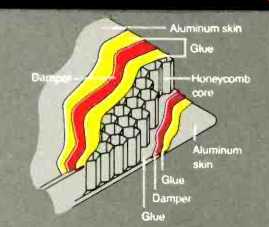
This high rigidity makes it possible to design a flat driver that is free of "cavity effect" The APM driver diaphragm is also well damped and exhibits virtually no internal resonances that can alter reproduction accuracy.
The APM tweeter in the APM 66ES speaker features a proprietary Sony technology in which a thin layer of amorphous diamond is deposited onto the flat aluminum honeycomb diaphragm. This results in not only great stiffness, but also extremely high sound propagation speed. Phase cancellations are largely eliminated, enabling the APM tweeter to reproduce frequencies ranging to 40,000Hz and above with exceptionally uniform dispersion.
Multi-Point Direct Dual-Surface Drive: APM driver diaphragms are square-shaped and driven at multiple points to avoid the problem of sectional vibrations, one of the major causes of speaker distortion. The woofer in the APM-66ES speaker, for example, is driven at no less than 8 points.
This ensures more efficient energy transfer and greatly reduces harmonic distortion for a cleaner, more transparent sound.
Plumb In-Line Configuration: The flat APM speakers' plumb in-line configuration assures that the sound arrives at the listener without frequency-dependent time delays. This results in more precise stereo imaging and the accurate reproduction of spatial relationships among the individual sound sources in a recording.
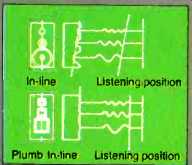
APM-66ES/APM-22ES

Digital audio the way it was meant to be heard.
Reference quality speakers with Sony's unique APM flat driver technology for sonic performance that fully meets the demands of digital audio.
- Extremely uniform, extended frequency response for superb tonal accuracy and smooth, untiring sound
- Exceptional power handling capability
- Low distortion and coloration not possible with conventional cone drivers
- Near-perfect linearity over a wide dynamic range
- Advanced crossover design for smooth response and stable stereo imaging over entire frequency range
- Built-in circuit breaker for tweeter protection
- Heavy-duty cabinet construction with rounded edges for reduced diffraction effects
- Optional speaker stands available
(adapted from Audio magazine, Sept. 1987)
Also see: Sony's ES--Digital Audio (Sept. 1985)
Sony ES Digital Series (Nov. 1986)
= = = =